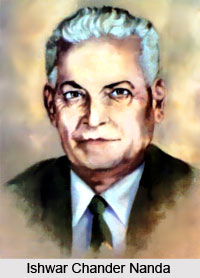 Ishwar Chander Nanda was very famous in realistic Punjabi theatre. Realistic Punjabi theatre were specially to relieve people of outmoded customs, conventions, and biases. He came to playwriting from amateur acting, which he had taken up inspired by Norah Richards in Lahore. She instituted a competition in playwriting where Nanda participated with his maiden attempt, Suhag or `Wedding` in 1913 was an one-act script in Punjabi. Adjudged the best, it was staged, with the result that he took to drama seriously after returning from England where he had gone for higher studies in English.
Ishwar Chander Nanda was very famous in realistic Punjabi theatre. Realistic Punjabi theatre were specially to relieve people of outmoded customs, conventions, and biases. He came to playwriting from amateur acting, which he had taken up inspired by Norah Richards in Lahore. She instituted a competition in playwriting where Nanda participated with his maiden attempt, Suhag or `Wedding` in 1913 was an one-act script in Punjabi. Adjudged the best, it was staged, with the result that he took to drama seriously after returning from England where he had gone for higher studies in English.
Ishwar Chander Nanda`s first full-length work, Subhadra in 1922 set him firmly on his course beyond the juvenile attempt he had given evidence of a decade earlier. It dealt with the issue of widow remarriage, for the resolution of which he employed secrecy and threats of exposure as dramatic tactics, not quite consistent with die nature of this theme. A college lecturer, he proved his fondness for Shakespeare by adapting The Merchant of Venice as Shamu Shah in 1928. But it was Ibsen who became a model for the mature Nanda. Varghar or Lily da viah or `Lily`s Marriage` in 1928 is a plea for love marriages against the orthodox practice of marital arrangements. Much like Ibsen, he seems to support youth against old people in the generational conflict. However, his advocacy rarely went beyond middle-class susceptibilities. Nanda`s three collections of one-act drama namely Jhalkare or `Reflections` in 1950, Lishkare or `Flashes` in 1953, and Chamkare or `Sparkles` in 1958 sometimes did overstep conservative sensibilities in forwarding criticism of religious superstition and economic discrepancies. His use of colloquial expressions rendered his dialogue forceful and dramatic. Irony and satire were other strategies that left nothing ambiguous about his intentions. Ishwar Chander Nanda died in 1961.




















